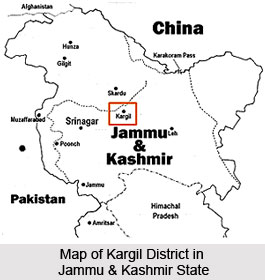 History of Kargil District states that Kargil is derived its name from two words Khar and rKil. Khar means castle and rKil means center thus a place between castles as the place lay amidst several kingdoms. There is an alternative theory regarding the etymological meaning of Kargil. It is also said that, the word Kargil has been derived from the words Gar and Khil. Gar in local language meaning `any where` and Khil means a central place where people could stay. This has the support of the fact that the place is central to Srinagar, Skardo, Leh and Padum with around 200 Kms. With the course of time Khar rKil or Gar Khil came to be known as Kargil.
History of Kargil District states that Kargil is derived its name from two words Khar and rKil. Khar means castle and rKil means center thus a place between castles as the place lay amidst several kingdoms. There is an alternative theory regarding the etymological meaning of Kargil. It is also said that, the word Kargil has been derived from the words Gar and Khil. Gar in local language meaning `any where` and Khil means a central place where people could stay. This has the support of the fact that the place is central to Srinagar, Skardo, Leh and Padum with around 200 Kms. With the course of time Khar rKil or Gar Khil came to be known as Kargil.
Ancient History of Kargil District
In the ancient time, the major part of present Kargil was known as Purig. The region called purig included the areas around Kargil town, Shaghkar Chiktan, Pashkyum, the Suru Valley, Bodh Kharbu and Mulbekh. This name has been given by the Tibetan scholars as the people living in this part of the land have the features of Tibetans. It probably dates to the year when a Tibetan dynasty first established a government in most of Purig. Human habitation seems to have been late in coming to this incredibly cold and rugged district perhaps as late as 500-0 BC. The Dards of the various little valleys of Gilgit were perhaps the first to settle here. They belonged to the so called Aryan `race`. The language, customs, racial characteristics and religious practices of the Dards can still be found in some areas like Da-Hanu and Chiktan-Garkun, and to some extent in shanghy-shaghar. Around the same period handful of people from the Indian plains, too, migrated to Purig. By the eight century AD there is evidence of sophisticated civilisation in Kashmir. Later, some people migrated to purig from Leh. They built a fort on the Tolon hill near the Indus. They also founded the Achinathang village. Ruins of that ancient settlement can still be found. In the eight (or may be early ninth) century AD, Gasho Thatha Khan started the dynasty that would rule over the Shakar and Chiktan area for almost a thousand years. He was a scion of the royal family of Gilgit.
Mediaeval History of Kargil District
Medieval history of Kargil District is marked with the advent of Islam. Islam first spread in Purig, through the efforts of the saint Ameer Kabeer Syed Ali Hamdani and his disciple Syed Muhammad Noor Bakhsh. It was also during this medieval era that the Mughals invaded Kargil. Islam came to Kargil in 15th century. Mir Shams-ud-Din Iraqi, a scholar of Shia school of central Asia visited Baltistan and Kargil with his missionaries to preach Islam. The chief of Baltistan embraced Islam first and it was later followed by the Chiefs of Kargil. Prior to Mir Shams-ud-Din Iraqi Khawaja Noor baksh visited Kargil and done a lot of Islamic preaching.
Modern history of Kargil District
Kargil became a separate district in the Ladakh region during the year 1979 when it was bifurcated from the erstwhile Leh district. Kargil is called the land of Agas in the present day world. It is due to the fact that Kargil is mostly inhabited by Shia Muslims and Agas are the religious head and preachers.



















